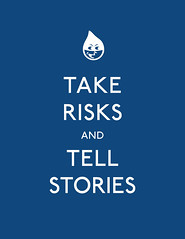 Recently I wrote a response to the Progressive Exchange Listserve regarding the question of whether or not to convert an active e-newsletter into a blog. The short answer, in my opinion is yes, you should convert your regular e-newsletter into a blog. But only if it makes sense for your organization to do so. For most it should make sense, but there is a hesitation to do so due to comfort in what has become the norm for many organizations. A few short years ago, the same question arose as to whether or not organizations should convert their published (on paper) newsletter into an e-newsletter. When organizations made that change from a traditional medium of physical print to digital copy, it was a revalation. Many haven’t looked back. Now, the question has arose again for the next fontier on the digital landscape.
Recently I wrote a response to the Progressive Exchange Listserve regarding the question of whether or not to convert an active e-newsletter into a blog. The short answer, in my opinion is yes, you should convert your regular e-newsletter into a blog. But only if it makes sense for your organization to do so. For most it should make sense, but there is a hesitation to do so due to comfort in what has become the norm for many organizations. A few short years ago, the same question arose as to whether or not organizations should convert their published (on paper) newsletter into an e-newsletter. When organizations made that change from a traditional medium of physical print to digital copy, it was a revalation. Many haven’t looked back. Now, the question has arose again for the next fontier on the digital landscape.
I have no experience other than my own to suggest how such a transition can work. However, I have made the successful transition from e-newsletter to blog with a high degree of success. I am drawing on my experience migrating United Cerebral Palsy’s (UCP) e-newsletter, UCPeople, to a blog platform. I managed all UCPeople posts from its inception to January 2010. UCP migrated in May of 2008. I have to say that it was one of the best moves I have ever been a part of while working with UCP. How we accomplished this was in the following phases:
- First, we built the blog on a platfom that worked for us (blogger). These days, however, I would recommend WordPress.org (not WordPress.com, because you cannot customize the .com version) for the customization ability or even a Posterous blog that is as simple to blog as writing and sending an e-mail;
- Second, once the appearance and design were finalized (there are free blogger templates at Pyzam.com if you are looking for preformatted templates and WordPress has an entire library of "themes" to choose from), we notified of the decision to migrate via e-mail to the e-newsletter e-mail subscription list.
- Third, we began blogging on topics that would introduce stalwart e-mail users to the features that make a blog great (e.g. what a blog is, an explanation of what RSS is, how to post a comment, how to get each post delivered by e-mail or via an RSS feed, how our flickr.com photostream worked and how to contribute user photos to the stream, etc.)
- Fourth, and this is purely at the discretion of each organization, the organization can send out a notice once/week letting the entrenched e-mail users know of the updates during the previous week with teaser text and a link to the article post. (I suggest setting an end-date for this because it can become a source of duplicate effort)
The question of metrics nearly always arises when there is a consideration of migration from an e-newseltter into a blog.For some, the organization values its list size rather than list activity. Measuring list size is similar to measuring output rather than achievement of the organization’s end outcome. I suggest, a search for what you can measure that will constribute to your performance measurement activities that are outcome indicators (e.g. level of engagement of your supporters, number of interactions and the type/quality of interactions, open/click through rates – if you are still using e-mail to notify of the latest activity on your blog, etc.).
Having a blog can render similar metrics to list growth in the following ways:
- By using Google Analytics or SiteMeter.com (a free service see the bottom of UCPeople as an example by clicking on the count of the number of lifetime visitors) you can measure site visits (unique and returning traffic), how long, on average a visitor stays, the number of pageviews, what they click on when leaving your site (with sitemeter), what geographical area they are visiting your site from, etc.;
- You can use Google’s Feedburner (a free service) to syndicate your feed to:
- get more search engine traffic relating to your issue and as a result cause an increased level of awareness about your organization and its mission;
- track the use of your feed (reach and reader metrics); and
- track all of your blog metrics in one place.
- Give you real-time activity response rates once you post an article; and
- No period holding your stories to launch a weekly e-newsletter; instead the organization can post as soon as it is ready. As a result keeping readers engaged and up-to-date with news and other items of interest distributed by your organization.
As far as donor capture, you can embed a radio button survey on your donation form (usually on the home Web site) that prompts the reader to select why they are making their donation that day with an “Other” text field in case you don’t have the option they are looking for. This will allow the organization to capture information and distinguish correlation to a given campaign. Also, you can track outbound traffic to the donation page using your blog metrics to further correlate information with the “why” of making a donation.
 There are several more benefits to hosting a blog versus hosting an e-newsletter. By having a blog or several, you can cross-pollinate each blog with the purpose and scope of your others to let the user self-select what they are interested in and want to read about. And the best part is if you have a new user, they can search the archive of posts to read what is already there rather than waiting for their next e-newsletter to arrive. They can become active on their own timeline, usually right away, when they are most likely to commit to an action or make a donation.
There are several more benefits to hosting a blog versus hosting an e-newsletter. By having a blog or several, you can cross-pollinate each blog with the purpose and scope of your others to let the user self-select what they are interested in and want to read about. And the best part is if you have a new user, they can search the archive of posts to read what is already there rather than waiting for their next e-newsletter to arrive. They can become active on their own timeline, usually right away, when they are most likely to commit to an action or make a donation.
If your organization is considering migrating from an e-newsletter to a blog, it is my hope that these benefits outweigh any negatives you might be facing to make your case. It is also my hope that the nonprofit sector ventures further into this space. Not only will it secure new supporters, but it will also aid your search engine rankings by supplying new and regular content surrounding your issue. In turn, more supporters will find your issue and some might even become evangelicals and work with you to achieve your mission. Blogging is becoming more a part of securing social change in our society. Should you migrate from an e-newsletter to a blog? Emphatically, yes!











